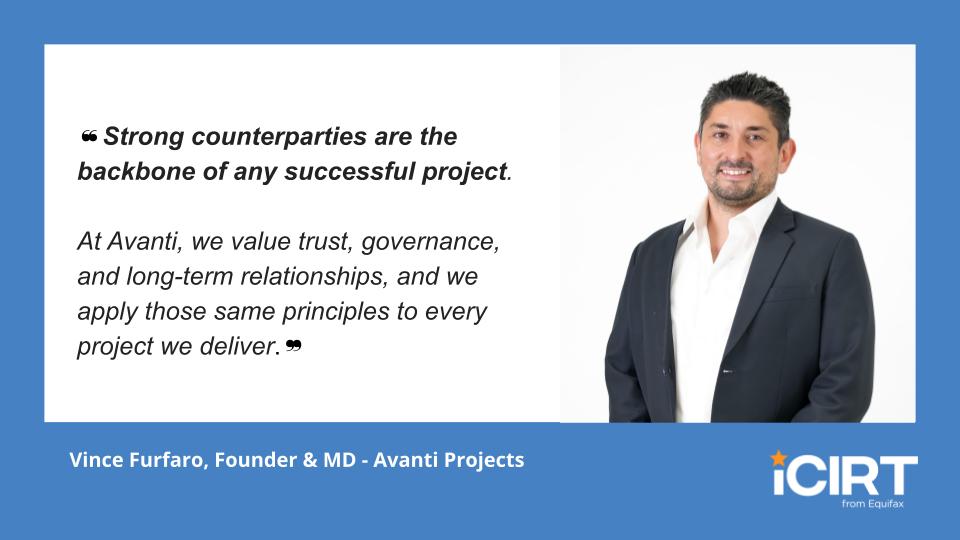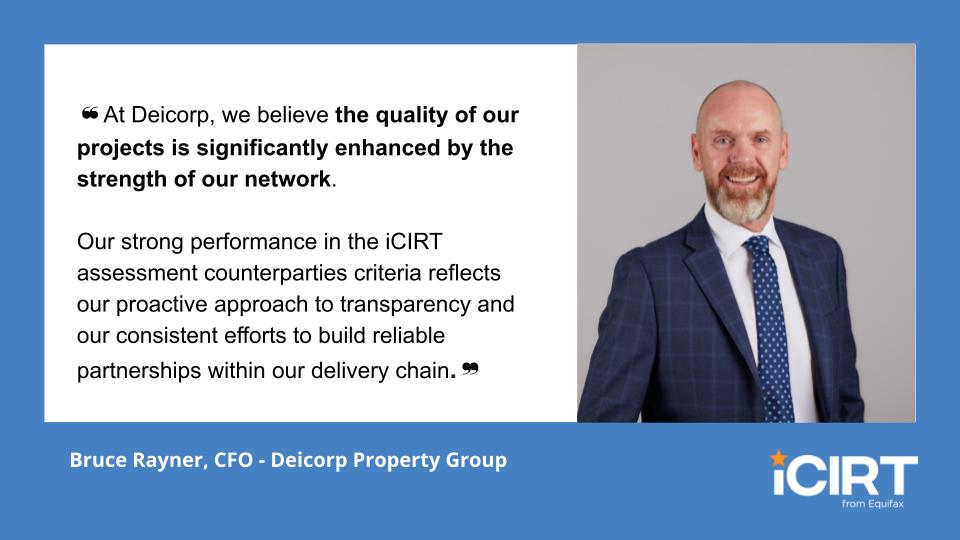
An iCIRT rating recognises the multifaceted elements that distinguish high-trust property development and construction companies. But what does this look like in practical terms?
This article is the sixth in a series designed to explain the iCIRT assessment process and illuminate 'What Good Looks Like' for businesses aspiring to achieve a strong rating. An iCIRT rating is the result of an objective and independent assessment across six critical pillars: Character, Capability, Conduct, Capacity, Capital, and Counterparties.
Here we focus on the ‘Counterparties’ pillar of the iCIRT assessment.
Defining 'Counterparties': How strong is your network?
The core premise of the ‘Counterparties’ pillar is that a business is only as strong and resilient as its network. In a cascaded delivery model like construction, a single weak link can expose the entire system to significant risk.
When iCIRT assesses a company’s 'Counterparties,' it is looking at the track record, governance and resilience of the business’s network. This is an extension of the 'Capability' pillar, which examines the internal governance, operational maturity, processes, and oversight of the business itself.
iCIRT rated Avanti Projects achieved a strong ‘Counterparties’ assessment score, reflecting the strength, governance, and track record of its business network.

‘Counterparties’ examines a business within the context of its broader ecosystem. This includes:
- Sponsors/guarantors: Those parties that are able to provide support and funding where needed.
- Related parties: A broad term covering related body corporates, entities linked by common directors, shareholders, or ultimate beneficial owners, as well as Special Purpose Vehicles (SPVs) and Joint Ventures (JVs).
- Key trading partners: Essential partners like a developer's builder, a builder's client (developer), or a managing contractor's key subcontractors. It may also include critical subcontractors if they represent a key link in the delivery chain.
The assessment seeks to determine if a business is likely to benefit from the strength of these counterparties or be hindered and impaired by their weaknesses.
Key areas of focus include:
Transparency:
Assessing whether the network structure and the transactions between related parties are clearly documented and typical of a business of its nature and size. If there is hidden complexity and an opaque structure, this can be seen as a constraint on the rating because it impedes line of sight and traceability.
Trustworthiness and track record:
Equifax data analysis shows a strong correlation where reliable, resilient, and trustworthy businesses tend to partner with others exhibiting similar high-quality behaviours. Conversely, there is an even stronger correlation observed at the other end of the spectrum: businesses exhibiting less reliable performance and adverse behaviours are highly likely to be engaging with other parties having similar behaviours.
Third-party management:
Scrutinising the internal processes for oversight, monitoring, and control of third-party engagements to avoid risky dependencies and weak controls.
iCIRT rated Worthington Homes achieved a strong ‘Counterparties’ assessment score, reflecting the strength, governance, and track record of its business network.

How to strengthen your 'Counterparties' profile for an iCIRT rating
Businesses aiming for a strong score in the ‘Counterparties’ iCIRT assessment can take several proactive steps. Here's “What Good Looks Like”:
Provide full transparency on your structure
Be proactive in providing clarity around your overall business structure and network of related parties, encompassing all related parties, the transactions between them (loans, investments, guarantees), and their inter-relationships.
⭐ While some businesses may be concerned about revealing too much, greater transparency about challenges and how you are learning and implementing changes strengthens your proposition and supports a favourable rating. Trustworthy businesses are able to demonstrate the necessary operational maturity, governance, and oversight in accordance with market expectations.
Establish mature third-party governance
Implement and demonstrate a clear, mature third-party management framework. This framework should detail how you:
- Identify and source: Select and assess potential partners and suppliers.
- Onboard and induct: Bring new counterparties into your delivery chain.
- Supervise and manage: Continuously monitor their performance and compliance, addressing any variances promptly.
This demonstrates robust governance over the supply chain, operating and delivery risk.
Manage financial linkages and dependencies
Be transparent about any guarantees, loans, or significant dependencies across the group. Furthermore, detail the internal assessments you have conducted to ensure you are comfortable with the risk appetite and risk tolerance of these dependencies. Highlight any controls or safeguards you have in place to protect against potential financial exposures.
iCIRT rated Deicorp Property Group achieved a strong ‘Counterparties’ assessment score, reflecting the strength, governance, and track record of its business network.

Conduct regular due diligence
Demonstrate that you run internal, holistic, and frequent due diligence activities across your partners and other related businesses. This practice shows a proactive approach to managing the trustworthiness and performance of your entire network.
⭐ The iCIRT methodology considers four critical linkages when determining the strength of support or risk that related parties bring to the rated entity:
- Legal and ownership linkages: This assesses the ownership structure, control, and influence between entities. It examines legal linkages such as formalised contracts and enforceable provisions that exist between related parties.
- Strategic linkages: This looks for evidence of shared strategic direction, including common brands, common intent, and common investments. It also considers the significance of the business's size and scale relative to the overall broader group.
- Financial linkages: This evaluates the financial connections and potential support mechanisms. It scrutinises the level of related party transactions, potential guarantees between entities, loan facilities, letters of credit, and any funds previously transferred to demonstrate support.
- Operational linkages: This focuses on the alignment and control across the group. It assesses the extent of managerial control, the similarity and consistency of governance processes, whether entities use the same processes and systems, and if centralised financial functions are used across the group.
By focusing on these elements of ‘Counterparties’, businesses can improve their iCIRT rating prospects by demonstrating that their network is a source of strength, not risk. Ultimately, the quality of a built asset is only as good as its weakest link, and the Counterparties pillar drives a culture of collective ownership and accountability across the entire delivery chain.
Useful resources:
Understand how we assess ‘Character’
Understand how we assess ‘Capability’
Understand how we assess ‘Conduct’
Understand how we assess ‘Capacity’
Understand how we assess ‘Capital’
